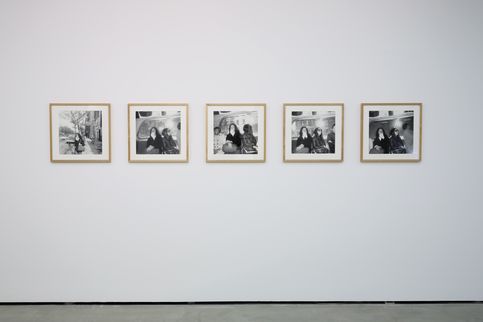Catalysis IV

Adrian Piper
Catalysis IV, 1971
Documentation of the performance 5 black-and-white photographs, silver gelatin on baryta paper (prints approx. 1998) 41 x 41 cm each, framed 50 x 52 cm each
GF0003326.00.0-2003
Artwork text
Talking to Myself IV. Concretized Ideas I’ve Been Working Around I can no longer see discrete forms or objects in art as viable reflections or expressions of what seems to me to be going on in this society: They refer back to conditions of separateness, order, exclusivity, and the stability of easily accepted functional identities that no longer exist. For what a posteriori seems to be this reason, the elimination of the discrete form as art object (including communications media objects) as a thing in itself, with its isolated internal relationships and self-determining aesthetic standards, really interests me. I’ve been doing pieces the significance and experience of which is defined as completely as possible by the viewer’s reaction and interpretation. Ideally the work has no meaning or independent existence outside of its function as a medium of change. It exists only as a catalytic agent between myself and the viewer. An example is Catalysis I, in which I saturated a set of clothing in a mixture of vinegar, eggs, milk, and cod liver oil for a week, then wore it on the D train during evening rush hour, and while browsing in the Marlboro bookstore on Saturday night. Making artificial and non function at plastic alterations in my own bodily presence of the same kind as those I formerly made on inanimate or non art materials. Here the art-making process and end product has the immediacy of being in the same time and space continuum as the viewer. This process/product is in a sense internalized in me, because I exist simultaneously as the amid arid the work; I define the work as the viewer’s reaction to it. The strongest, most complex, and most aesthetically interesting catalysis is the one that occurs in uncategorized, undefined, non pragmatic human confrontation. The immediacy of the artist’s presence at art work/catalysis confronts the viewer with a broader, more powerful, and more ambiguous situation than discrete forms or objects. For example, Catalysis IV, in which I dressed very conservatively but stuffed a large white bath towel into the sides of my mouth until my cheeks bulged to about twice their normal size, letting the rest of it hang down my front and riding the bus, subway, and Empire State Building elevator; Catalysis VI, in which I attached helium-filled Mickey Mouse balloons from each of my ears, under my nose, to my two front teeth, and from thin strands of my hair, then walked through Central Park and the lobby of the Plaza Hotel, and rode the subway during morning rush hour. Preserving the impact and uncategorized nature of the confrontation. Not overly defining myself to viewers as artwork by performing any unusual or theatrical actions of any kind. These actions tend to define the situation in terms of the pre-established categories of ”guerrilla theater,” ”event,” ”happening,” ”street work,” etc., making disorientation and catalysis more difficult. For example, Catalysis Ill, in which I painted a set of clothing with sticky white paint with a sign, attached saying ”WET PAINT,” then went shopping at Macy’s for some gloves and sunglasses; Catalysis V in which I recorded loud belches made at five-minute intervals, then concealed the tape recorder on myself and replayed it at full volume while reading, doing research, and taking out some books and records at Donnell Library. For the same reason I don’t announce most of these works, as this immediately produces an audience- versus-performer separation and has the same effect psychologically as a stage surrounded by rows of chairs has physically. Art contexts per se (galleries, museums, performances. situations) are becoming increasingly unworkable for me; they are being overwhelmed and infiltrated by bits and pieces of other disintegrating structures: political, social, psychological, economic. They preserve the illusion of an identifiable, isolatable situation, much as discrete forms do, and thus a pre-standardized set of responses. Because of their established functional identities, they prepare the viewer to be catalyzed, thus making actual catalysis impossible (rather than its more comfortable illusion, which consists of filling in the particulars of an aesthetic experience, the general outlines of which are predetermined). Alternate contexts I’ve been using include subways, buses, Macy’s, Union Square, the Metropolitan Museum of Art (as a spectator in Catalysis VII, in which I went to the ”Before Cortes” show while chewing large wads of bubble gum, blowing large bubbles, and allowing the gum to adhere to my face), and so on. Eliminating as many decision-making steps, procedures, and controls as possible. This has a necessary psychological function for me in that it decreases or eliminates the separation between original conception and the final form of an idea; the immediacy of conception is retained in the process/product as much as possible. For this reason I have no way of accounting for the final form that an idea takes. It may be objected that all the ideas described above constitute decision-making criteria, but in fact just about everything I’ve written occurred to me a posteriori, including the idea expressed in this paragraph. Which may mean it’s time to start doing something else. (Adrian Piper)





